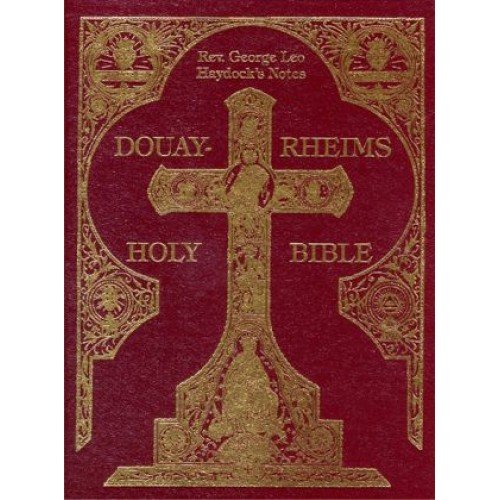Bible Translations (Part 2)
And when Moses came down form the Mount Sinai, he held the two tables of the testimony, and he know not that his face was horned from the conversation of the Lord. And Aaron and the children of Israel seeing the face of Moses horned, were afraid to come near.
Exodus 34:29-30 (Douay - Rheims)

image source
The first English translation of the New Testament from the original Greek appeared in 1535 and quickly won a wide readership. In response to the flood of translations that followed, the Catholic Church (which persecuted Bible translators for years) authorized a version of their own, the Douay - Rheims Bible. The NT was published in 1582, followed by the OT with apocrypha in 1610 (one year before the KJV).

Image source
One of the curiosities of this translation (at least for modern readers) is the Exodus passage which says that Moses' face was "horned" when he spoke with God on Mount Sinai. This rendering, based on the Latin version, inspired numerous medieval sculptures and paintings of a horned Moses. While the original Hebrew can indeed mean "to grow horns," it can also mean "to shoot forth rays." Although this misunderstanding might not be of great consequence, we can see from this example how easy it can be to get imperfect information from translation.
It is also possible to get imperfect information from translations that are excellent. For example, when Jesus says that there are "many mansions" in His Father's house (John 14:2), the Greek word simply implies a place to live, not the imposing residence that we associate with the word "mansion." This is not a fault of the translation; it is simply an example of a word whose meaning has changed over the course of time. In 1611, the word "mansion" meant a "dwelling place" or an "abode," which is exactly how the same Greek word is translated later in the same chapter (John 14:23)
For another example, consider 2 Timothy 2:15 (KJV):
Study to shew thyself approved unto God, a workman that needeth not to be ashamed, rightly dividing the word of truth.
For years I have used this verse to emphasize the importance of Bible study, and while Bible study is still very important and this verse does emphasize the need to handle God's word with care, the initial word "study" is not referring specifically to Bible study. The original word here means "to give diligence" and this is how the word is rendered in most English translations. The KJV translators chose the word "study" because "to give diligence" was one of the meanings of the word "study" in the early 17'th century in England.
Other words whose meaning have changed include:
- Conversation (Philippians 3:20)
- Careful (Philippians 4:6)
- Convenient (Ephesians 5:4)
- Cuerious (Exodus 28:8)
Still others have disappeared from standard usage altogether, such as:
- Blains (Exodus 9:9)
- Bray (Job 6:5)
- Clouts (Jeremiah 38:11)
- Earing (Genesis 45:6)
- Hosen (Daniel 3:21)
- Leasing (Psalms 4:2)
- Pate (Psalms 7:16)
- Poll (2 Samuel 14:26)
- Sith (Ezekiel 35:6)
While the KJV is an excellent translation, we nean to understand that the language has changed somewhat since King James was on the throne.
This is why I highly recommend using a variety of translations in personal Bible study. If you are reading primarily from the KJV and encounter a word with which you are not familiar, a 21st century dictionary might not help you (and could even misguide your study). In this situation it could be especially helpful to consult another translation. Then again, you might try reading through a different translation altogether this year. If you do, you will likely be surprised at the things you notice that you never detected before. But which translations are the best for your personal study? Stay tuned.
✅ Enjoy the vote courtesy of @themadcurator! Please consider following and casting a witness vote for @themadcurator to show your support! Just click here, it's easy!